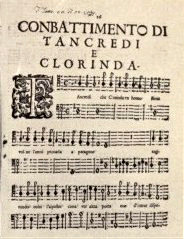
Torquato Tasso was an Italian poet of the 16th century, known for his 1591 poem Gerusalemme liberata, in which he depicts a highly imaginative version of the combats between Christians and Muslims at the end of the First Crusade, during the Siege of Jerusalem of 1099.

Giovanni Battista Tiepolo, also known as GiambattistaTiepolo, was an Italian painter and printmaker from the Republic of Venice who painted in the Rococo style, considered an important member of the 18th-century Venetian school. He was prolific, and worked not only in Italy, but also in Germany and Spain.

Jerusalem Delivered, also known as The Liberation of Jerusalem, is an epic poem by the Italian poet Torquato Tasso, first published in 1581, that tells a largely mythified version of the First Crusade in which Christian knights, led by Godfrey of Bouillon, battle Muslims in order to take Jerusalem. Tasso began work on the poem in the mid-1560s. Originally, it bore the title Il Goffredo. It was completed in April, 1575 and that summer the poet read his work to Duke Alfonso of Ferrara and Lucrezia, Duchess of Urbino. A pirate edition of 14 cantos from the poem appeared in Venice in 1580. The first complete editions of Gerusalemme liberata were published in Parma and Ferrara in 1581.

Armida is the fictional character of a Saracen sorceress, created by the Italian late Renaissance poet Torquato Tasso.

Il combattimento di Tancredi e Clorinda, SV 153, is an operatic scena for three voices by Claudio Monteverdi. The libretto is drawn from Torquato Tasso's La Gerusalemme Liberata. It was first performed in Venice in 1624, and printed in 1638 in Monteverdi's eighth book of madrigals. Monteverdi used musical features here for the first time to enhance the dramatic depiction of a battle in stile concitato, such as pizzicato and tremolo.

Giovanni Battista Piazzetta was an Italian Rococo painter of religious subjects and genre scenes.

Antonio Tempesta, also called il Tempestino, was an Italian painter and engraver, whose art acted as a point of connection between Baroque Rome and the culture of Antwerp. Much of his work depicts major battles and historical figures.
Giuseppe Antonio Ghedini was an Italian painter of the Baroque period, mainly active in Ferrara.

Armida is an operatic dramma per musica by Antonio Salieri in three acts, set to a libretto by Marco Coltellini. The plot is based on the epic poem Gerusalemme liberata by Torquato Tasso. Lully, Handel and Traetta, to name but a few, had already composed operas based on the situations that Tasso originally developed. The plot of all of these, and Salieri's work, is based on the relationship between Armida and the Crusader Rinaldo.

Paolo Domenico Finoglia, or Finoglio, was an Italian painter of the early-Baroque period, active mainly in South Italy, including Naples and towns in Apulia.

Armida is an opera seria in three acts with music by Antonio Sacchini set to a libretto by Jacopo Durandi, based on the epic poem Gerusalemme liberata by Torquato Tasso. The opera was first performed during the 1772 Carnival season at the Teatro Regio Ducale in Milan.
Nationality words link to articles with information on the nation's poetry or literature.

Antonio Baratti was an Italian engraver, etcher and printmaker.

Edward Rooker was an English engraver, draughtsman and actor.

The Mighty Crusaders is a 1957 film about the First Crusade (1096–1099), based on the 16th-century Italian poem Jerusalem Delivered by Torquato Tasso.

Pietro Antonio Novelli (1729–1804) was an Italian painter and engraver.
Luigi Maria Viviani was an Italian composer, conductor and violinist of Florentine origin. He was primarily noted for his ballet scores, most of them composed for the choreographers Giovanni Galzerani and Antonio Cortesi. His 1851 score for Fausto was particularly praised for its obbligato written for the bimbonclaro.
The Crusaders or Jerusalem Liberated is a 1918 Italian silent historical film directed by Enrico Guazzoni. It is based on the poem Jerusalem Delivered by Torquato Tasso. The film is set during the Crusades and describes Godfrey of Bouillon's conquest of Jerusalem in 1099.














